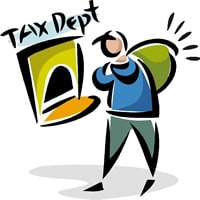 Rural counties largely depend on the property tax to finance their activities. Taxing real estate for local government is a legacy from the days when land ownership was the principal source of individual wealth.
Rural counties largely depend on the property tax to finance their activities. Taxing real estate for local government is a legacy from the days when land ownership was the principal source of individual wealth.
The property tax generates a steadily declining share of local revenues according to a recent volume, Nancy Y. Augustine, et al., Erosion of the Property Tax Base: Trends, Causes, and Consequences (Lincoln Institute of Land Policy, 2009). The property-tax base is being narrowed by incentives and tax breaks that local governments provide to promote or protect specific public purposes, such as economic development, conservation, agriculture (land-use taxation), non-profits, religious activities and favored groups (e.g., homestead exemptions, senior citizens, veterans). The Lincoln Institute is a wonderful source of information on property taxes and other land issues.
Like many rural counties, mine — Highland County, Virginia — is overwhelmingly dependent on the property tax to fund its school system and other services. We don’t have a local sales tax or personal-income tax. Our business base is very small. Since almost all of the county is either agricultural land or woods, a land-use break for farmers and timberland owners would not work. We’d simply have to tax the same folks differently to raise needed tax revenues.
And like many rural counties, our budget is pummeled from every side–unfunded federal and state mandates, state budget cuts, lower school enrollment (which reduces the amount of state assistance), increases in the costs of services provided, taxpayer resistance to higher taxes, assessment values increasing periodically, and so on.
Two points, among dozens, can be offered on this complicated subject.
The federal government sent 1,850 local governments with federal land holdings in their jurisdictions about $381.65 million in FY 2009 in payments in lieu of taxes (PILTs). This was more than three times the FY 1999 total payment of $124.6 million.
Individual state payments, county-by-county, can be accessed at www.doi.gov/pilt/ for FYs 1999-2009. For illustration, Virginia’s average PILT payment per acre in FY 2009 was $1.86; Mississippi’s $.90; California’s $.79.
Twenty percent (54,526 acres) of Highland’s 266,240 acres is federally owned. We received $91,526 in PILT payment in FY 2009, or about $1.68/acre. Undeveloped private land is taxed at $8/acre and up, agricultural land higher than woods. At a minimum, Highland loses more than $6/acre over the PILT payment in annual property tax revenue for each acre of federal land every year.
Every county that receives PILT money has to make up in some way this loss. Private property owners must pay higher property taxes to offset the lost revenue from federal lands. While PILT payments have increased per acre over the years, the underpayment compared with private property payments continues to burden real-estate owners in rural counties.
The PILT formula should be adjusted to better compensate counties for federal land ownership—something like 100 percent of the average per-acre tax levied on privately owned property of each land type.
A second area where the property-tax base has been narrowed is on land that has been encumbered with a conservation easement. My back-of-the-envelope guess is that more than 10 million privately owned acres are currently enrolled with land trusts, national land conservation organizations or public agencies. (A fair amount of Googling did not turn up a current total.)
Federal tax policy provides generous benefits to private landowners who donate a right of use on their properties for conservation purposes. (See Trust for Public Land, The Conservation Easement Handbook, Chapter 6 and IRC Section 170 [h] and IRS Treasury Regulations Section 1.170 A-14.)
Once the landowner has given away a valuable right in his property to the easement-holding organization, his property is now worth less than it was. And its tax-assessed value should be lowered to reflect the loss of market value. This means, of course, that the county loses property-tax revenue. The easement-holding organization doesn’t pay property tax on the right it now owns, because it’s either a non-profit or a public agency.
If, in other words, an owner severed the right to develop his property or sell its timber commercially, its market value might be reduced by half or more. Thus, the tax-assessed value could be reduced by that percentage as well and property tax revenue from that land will be lowered in perpetuity to reflect the subtraction of the donated right.
My feeling is that the federal tax benefits (and state benefits where applicable) are sufficient to reward landowners who want to use a conservation easement.
Some counties can afford the loss of tax revenue that results, and others can’t. If all property were in conservation easements, then the property-tax rates would be raised on all property owners to generate needed revenue. Since all property is not in easements (and can’t be), the burden of the tax loss is shifted to other revenue sources, usually other real-estate owners who have not or cannot use such easements.
My guess is that most jurisdictions can’t maintain valuations on conservation property at the pre-easement level. Therefore, I think that those who donate those rights should consider voluntarily paying property tax on the basis of what would have been levied in the absence of the easement, depending on the needs of the particular county.
This content may not be used or reproduced in any manner whatsoever, in part or in whole, without written permission of LANDTHINK. Use of this content without permission is a violation of federal copyright law. The articles, posts, comments, opinions and information provided by LANDTHINK are for informational and research purposes only and DOES NOT substitute or coincide with the advice of an attorney, accountant, real estate broker or any other licensed real estate professional. LANDTHINK strongly advises visitors and readers to seek their own professional guidance and advice related to buying, investing in or selling real estate.









Taxes are simply a means of paying those who are to lazy to get a real job and work for a living. Taxes came about as a result of the 1913 bull crap meeting on Jekyll Island between a group of very rich industrial giants and a few not so honest politicians. Honesty has never been in the government and never will be.